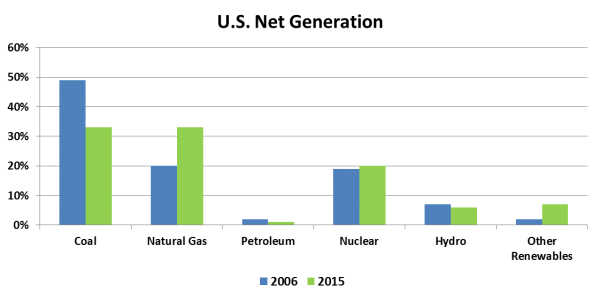Have questions or need help? Give us a call: 1-(888)-364-9259
Renewable energy generation is no longer a novelty. The growth of renewable energy is evident all around us. From solar panels to wind turbines, renewable energy is becoming more common. While solar panels continue to pop up on rooftops in your neighborhood, it is a good time to review how our energy generation landscape is changing.
The chart below presents data compiled by the U.S. Energy Information Administration. It shows how electricity generation in the U.S. has changed over the past decade.

Electricity generated from nuclear, petroleum and hydro sources was stable from 2006 thru 2015. The big changes were in coal, natural gas, and renewable energy.
Coal-fired power plants are on the decline. Clean air regulations and other factors have increased the cost of producing electricity from coal. As coal-fired units are retired, their capacity is replaced by cleaner and more economical sources. For the most part, natural gas has been the fuel of choice for replacing coal-fired units.
Natural gas is cheap, plentiful, and burns cleaner than coal. It is also easier to find a spot to install natural gas generation. Coal-fired power plants require a good deal of real estate. First, you need a massive cooling reservoir for the steam turbines. You also need some space to handle the waste products from burning coal. Natural gas units do not require a lot of space. They have more flexibility on sizing and placement. This allows strategic placement of natural gas generation throughout the power grid.
While natural gas is shouldering most of the reduction in coal power, renewable energy has emerged as solid contributor to the national generation mix. In 2006, renewable energy represented only 2% of the nation’s net generation. By 2015, this increased to 7%. This number is continuing to grow at an incredible pace.
Wind and solar installations represented 67% of all new electricity generating capacity in 2015. Projections for 2016 show solar energy installations ramping up sharply and even outpacing new wind installations. In fact, 2016 projected solar energy installations are greater than the past three years combined. Simply put, most new power generation is renewable.
What do this mean for us as consumers? The fuels used to supply our electricity are changing. This changes the economics of the wholesale electricity market. From the underlying cost of producing electricity to price volatility, the market is changing. Renewable energy is growing at an impressive pace. It will play a larger role in our generation mix and help improve air quality.
Renewable energy, however, subject to the whims of nature. It requires sunny days and reliable breezes. For this reason, coal, natural gas, and nuclear power generation will continue to provide the majority of electric generation for the near future.